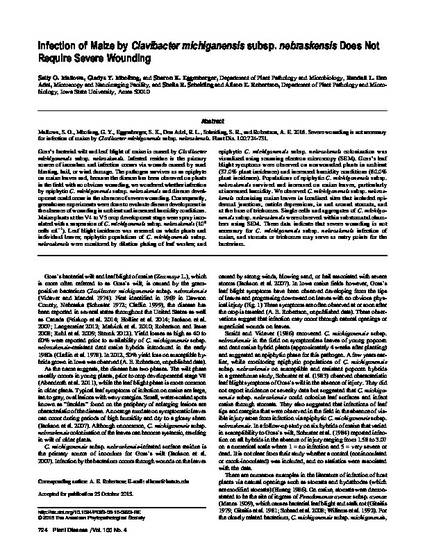
Goss’s bacterial wilt and leaf blight of maize is caused by Clavibacter michiganensis subsp. nebraskensis. Infested residue is the primary source of inoculum and infection occurs via wounds caused by sand blasting, hail, or wind damage. The pathogen survives as an epiphyte on maize leaves and, because the disease has been observed on plants in the field with no obvious wounding, we wondered whether infection by epiphytic C. michiganensis subsp. nebraskensis and disease development could occur in the absence of severe wounding. Consequently, greenhouse experiments were done to evaluate disease development in the absence of wounding in ambient and increased humidity conditions. Maize plants at the V4 to V5 crop development stage were spray inoculated with a suspension of C. michiganensis subsp. nebraskensis (108 cells ml−1). Leaf blight incidence was assessed on whole plants and individual leaves; epiphytic populations of C. michiganensis subsp. nebraskensis were monitored by dilution plating of leaf washes; and epiphytic C. michiganensis subsp. nebraskensis colonization was visualized using scanning electron microscopy (SEM). Goss’s leaf blight symptoms were observed on nonwounded plants in ambient (37.0% plant incidence) and increased humidity conditions (60.0% plant incidence). Populations of epiphytic C. michiganensis subsp. nebraskensis survived and increased on maize leaves, particularly at increased humidity. We observed C. michiganensis subsp. nebraskensis colonizing maize leaves in localized sites that included epidermal junctions, cuticle depressions, in and around stomata, and at the base of trichomes. Single cells and aggregates of C. michiganensis subsp. nebraskensis were observed within substomatal chambers using SEM. These data indicate that severe wounding is not necessary for C. michiganensis subsp. nebraskensis infection of maize, and stomata or trichomes may serve as entry points for the bacterium.
Available at: http://works.bepress.com/alison-robertson/248/

This article is published as Mallowa, Sally O., Gladys Y. Mbofung, Sharon K. Eggenberger, Randall L. Den Adel, Sheila R. Scheiding, and Alison E. Robertson. "Infection of Maize by Clavibacter michiganensis subsp. nebraskensis Does Not Require Severe Wounding." Plant Disease 100, no. 4 (2016): 724-731. doi: 10.1094/PDIS-08-15-0923-RE. Posted with permission.